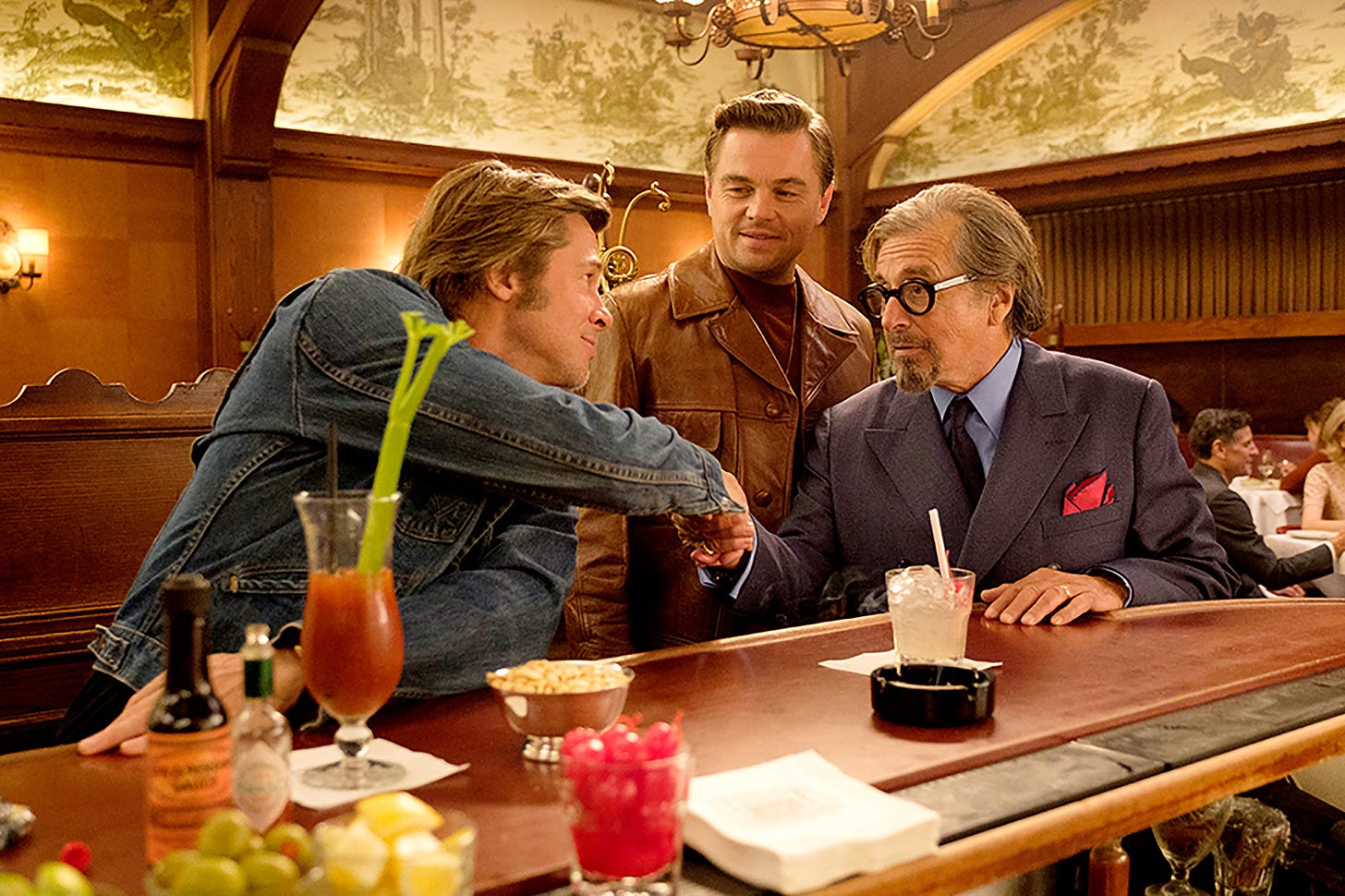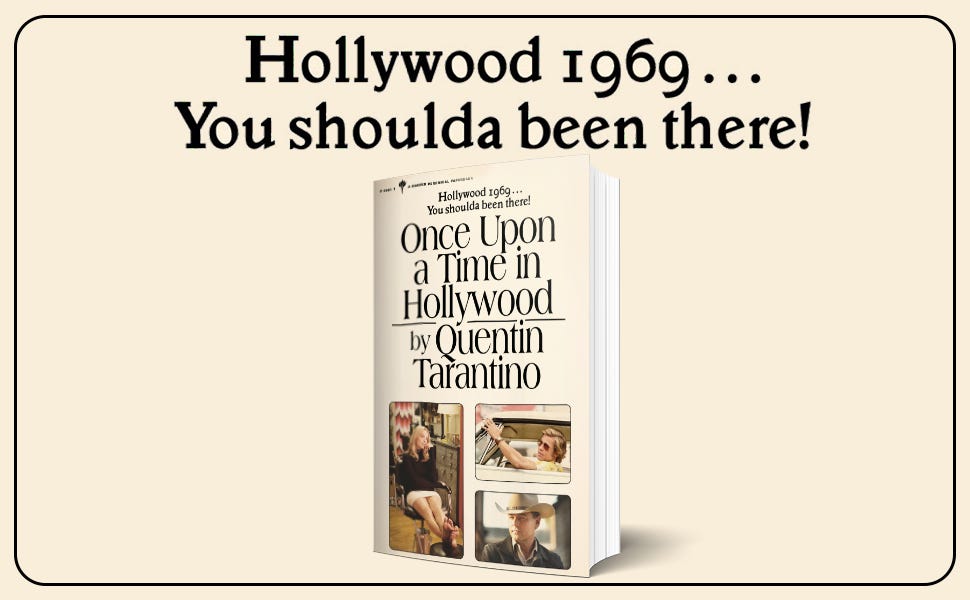Odds and Sods: Five Thoughts on Quentin Tarantino's Novelization of 'Once Upon a Time in Hollywood'
What the director's first foray into paperback fiction says about his discursive nature, his key obsessions and novelizations as a form.
It was perhaps inevitable that Quentin Tarantino, that devotee of fictions pulp, would try his hand at writing his own version of the dime store paperback, those lurid, punchy, down-and-dirty novels that have been the literary backbone of the films he loves (and makes). But this year’s Once Upon a Time in Hollywood, based on his 2019 film of the same title, is not that book. It’s technically a novelization, but it doesn’t really behave like one of those, either. So what is it? And what does it reveal about its author and his vision of 1969 Los Angeles? A few notes:
1. This is only technically a book.
This is not a proper novel. It is only occasionally a novelization. And if you were to read it without any knowledge of the film, it wouldn’t be illegible, but it never behaves like a story its reader is encountering for the first time. The book is perhaps best likened to the supplemental material on an album reissue—B-sides, extended takes, alternative recordings and songs that didn’t make the cut at all.
For those who pined for a version of Once Upon a Time in Hollywood that’s all Cliff Booth riding around late ‘60s Los Angeles with the top down, taking in the world that Tarantino and company so lovingly rendered, there’s not as much of that as you might expect. For one, Tarantino’s immense talent for on-screen world building doesn’t translate into great descriptive power as a writer. (As opening lines go, “The buzzer on Marvin Schwarz’s desk Dictaphone makes a noise” is not exactly Raymond Chandler’s “It was about eleven o’clock in the morning, mid October, with the sun not shining and a look of hard wet rain in the clearness of the foothills.”)
Were it not so delightfully discursive, the book would be understood as a softcover screenplay— short on poetic language, long on dialogue, with mostly minimal scene-setting. That doesn’t put it far off from the tradition of the genre books it’s emulating, but it never paints a particularly vivid picture, either. It’s written with the expectation that readers have seen the film and can easily imagine the backdrops and characters without Tarantino needing to take the trouble to conjure them in mere words.
The Reveal is a reader-supported newsletter dedicated to bringing you great essays, reviews and conversation about movies (and a little TV). While both free and paid subscriptions are available, please consider a paid subscription to support our long-term sustainability.
2. The auteur is the author of the book. The author is the auteur of the film.
Talking about authorship in a collaborative art like film can be a fraught conversation, to put it mildly, but the best directors impose their perspective on viewers, to show the world as they see it—their obsessions (and fetishes), their points of emphasis, their understanding of human behavior, etc. That’s never in question with a book, obviously, because other than an editor, there’s no mediating presence between the author and what actually makes it on the page. That means Once Upon a Time in Hollywood expresses Tarantino’s interests in the rawest possible form.
The first two chapters introduce Rick Dalton and Cliff Booth, the fading western star and his stunt double, played in the film by Leonardo DiCaprio and Brad Pitt. But those chapters are really about film history and criticism: The first expands on the scene where Rick meets Marvin Schwarz (Al Pacino), the agent who persuades him to fly to Italy and star in spaghetti westerns, Here, the scene becomes an exhaustive detailing of how Italian westerns became an appealing destination for stars like Rick who were past their primes yet still wanted to play the hero rather than a snarling villain for some up-and-comer to dispatch.
The disappointing trajectory of Rick’s career comes up again more poignantly later. Here,Tarantino is telling the story of the many almost-wases who only hardcore cinephiles like him will remember.
The second chapter follows Cliff on a date (with Marvin’s receptionist) to see I am Curious (Yellow), the Swedish erotic drama made in 1967 but not released until March 1969 in the U.S., where its sexual candor brought controversy and (eventually dismissed) obscenity charges. But the chapter is really about Tarantino outlining his own tastes through Cliff: the actors he adores (Toshiro Mifune, Alan Ladd, Jean-Paul Belmondo), the foreign directors he loves (Godard, Kurosawa, early Fellini without Giulietta Masina), the foreign directors he hates (Bergman, Antonioni, late Fellini or Fellini with Masina), and so on.
In other words, before it begins to open the period up to a wider lens or does much in the way of storytelling, the book feels like the autobiography of a moviegoer. Tarantino’s films are discursive by nature, but even he understands that the audience can only be pulled so far down one obscure tributary or another before it gets restless to get back on the river. Here he gives himself the freedom to write a book that’s all tributaries: He trusts that Once Upon a Time in Hollywood the film has already provided all the narrative backbone he needs to situate the reader. And so he can dig into film history and criticism; he can supplement set pieces with more expansive context and detail; and he can use some chapters to tell separate stories altogether.

3. The book suggests which sequences matter to him the most.
The funniest little flourish in the book is that Tarantino barely mentions the film’s violent climax, which is settled in a few paragraphs a quarter of the way through, but spends a generous chapter on how Cliff came to adopt the pitbull that figures so decisively into the scene. (The publicity boost to Rick’s career in the aftermath of the climax, not included in the film at all, also gets more space.) But he luxuriates over other set pieces: Cliff paying a visit to Spahn Ranch, the former movie set now overrun by members of Charles Manson’s “family,” who are taking advantage of its senile old proprietor; Sharon Tate settling in to a matinee of The Wrecking Crew, quietly elated at the strangers around her laughing at her on-screen klutz routine; Rick on set playing yet another baddie on someone else’s TV show, but inspired by a young actress to play it to the hilt.
That last bit actually gets scattered over multiple chapters, taking up enough pages to qualify as the heart of the book—and, by implication, the film itself. Rick Dalton has been spending 1969 coming to terms with his on-screen mortality, starting with that meeting with Marvin Schwarz, whose frank assessment of his career hits like a cold splash to the face. So, his one-off on this show, Lancer, makes him uncomfortable not just because the director wants him dressed in hippie garb (frilly coat, shaggy facial hair) far from the old-school cowboy he imagines himself to be. But Rick comes to realize that cowboy is gone now, along with the dream of having Steve McQueen’s career. A all that’s left is the work. It takes this committed, Method-y little girl to shake him from his hangover and restore his pride. He may be a footnote in Hollywood history, but on this day, in front of that camera, he’s going to deliver the goods.
4. Tarantino has his eyes fixed on the end of his own career.
There are some filmmakers, like Spike Lee or the late Jonathan Demme, who understand/understood their careers as a never-ending stream of creative opportunities, with big studio features interspersed with concert films or documentaries or other determinedly “minor” projects. Tarantino is not that kind of guy. Not only does he understand each of his films to be events, usually with a few years of planning between them, but he long ago conceived of his career as having a 10 film arc. Without actually uttering John Carpenter’s name, he told the sex monster Charlie Rose back in 1995 that he never wanted to get to a point where he’d lost his creative edge but kept on working as a shadow of his former self. Under his self-imposed schedule, Once Upon a Time in Hollywood would be his second-to-last film, and both the movie and the book have that tone to it—bittersweet, full of lament about a lost (and better) past, animated by the camaraderie of old friends and moments of true creative satisfaction.
The novel features a scene absent from the film where Lancer star James Stacy — one of several real-life figures used as supporting characters destined to experience tragedy or death within a few years of the story's events — invites Rick and Cliff out for drinks, and it feels like an Irish funeral. It’s a gathering of rambunctious Hollywood relics and relics-to-be trading stories in a watering hold that’s as out of place and time as they feel. It’s here that Rick can tell the hard truth behind his story about almost getting McQueen’s part in The Great Escape, and perhaps come to terms with it, too. Tarantino is laying a wreath at the Tomb of the Forgotten Actor here, and it’s beautiful to see.
5. Whatever this thing is, it’s good.
There’s no doubt many willl find this novel a mere indulgence. It is perhaps guilty of addressing questions that nobody asked and needn’t be answered, but “indulgent” tends to be a term that only gets applied to the work of an artist you don’t like regardless. There’s a playfulness to this book that’s surprising and sometimes exhilarating, whether Tarantino is fiddling with structure or the unwritten rules of novelizations, or going off on tangents that fill out the film’s world.
We get, for example, a long scene of Spahn’s domestic life with Squeaky Fromme, which Cliff may be correct in understanding as exploitative, but which also has private moments of real affection between both parties. We get that story of Cliff and his pitbull Brandy, which starts with an odyssey through underground Los Angeles dog fighting. We get a chilling “kreepy krawl” where one of Manson’s girls slips through the home of an elderly couple in Pasadena. Some chapters read like short stories, others like whole pages that he knew wouldn’t fit into a screenplay but felt compelled to write anyway. Tarantino’s movies are a vivid illustration of how he sees the world. This book is a window into how he thinks.





I also laughed very loudly in public at QT's brazenness in the recap of Trudi's post-Lancer career.
You did a nice job of capturing this books weird charms. If, after his 10th film (I still think KILL BILL should only count as one, but he's the boss), Tarantino wanted to go back and do this same thing for BASTERDS, DJANGO and KILL BILL, I wouldn't complain.